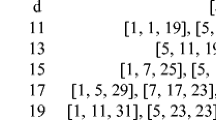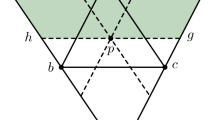Abstract.
It is proved that, for any ɛ>0 and n>n 0(ɛ), every set of n points in the plane has at most triples that induce isosceles triangles. (Here e denotes the base of the natural logarithm, so the exponent is roughly 2.136.) This easily implies the best currently known lower bound, , for the smallest number of distinct distances determined by n points in the plane, due to Solymosi–Cs. Tóth and Tardos.
Similar content being viewed by others
Author information
Authors and Affiliations
Additional information
Received: February, 2002 Final version received: September 15, 2002
RID="*"
ID="*" Supported by NSF grant CCR-00-86013, PSC-CUNY Research Award 63382-00-32, and OTKA-T-032452
RID="†"
ID="†" Supported by OTKA-T-030059 and AKP 2000-78-21
Rights and permissions
About this article
Cite this article
Pach, J., Tardos, G. Isosceles Triangles Determined by a Planar Point Set. Graphs Comb 18, 769–779 (2002). https://doi.org/10.1007/s003730200063
Issue Date:
DOI: https://doi.org/10.1007/s003730200063




